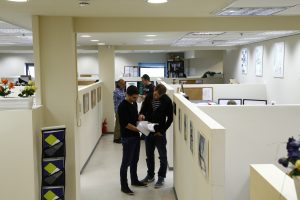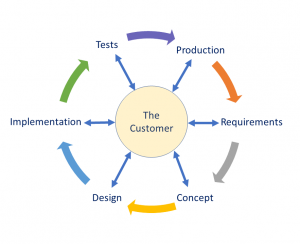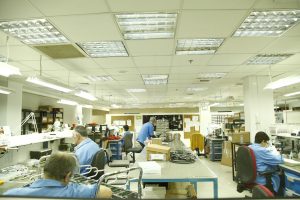Many companies already realize that services like IT services, CFO services, or cleaning services should be outsourced.
The outsourcing of peripheral services enables company employees to focus on areas where they are strong and to promote them instead of dealing with subjects that others have more experience in, enabling more efficient execution of the work at a similar cost or less.


Design Reviews with the customers
Despite the growing tendency to use outsourcing services, many are mistakenly perceived that the technical development of the product itself or the prototype, cannot be outsourced. Many mistakenly believe that technical realization, or in other words, the core of the company’s technology, is an integral part of their core knowledge and invests a lot of resources in it, that can be attributed to the company real business
development .
When a company is established, the entrepreneurs have two options: first, to recruit workers in the necessary technical fields, to rent offices, to buy furniture and equipment without understanding the complete needs, whether the people hired are suitable, or w


Sysmop Technologies R&D team
hether the equipment purchased is the equipment required for the work. The second option is to contact a company specializing in development, a company that already employs exactly the right people, which already has all the necessary equipment and most important, has continuous experience in doing exactly what the entrepreneurs do not
specialize in.
If the entrepreneurs decide to proceed with the first option, they will spend much of their time managing a professional technical staff, with no possibility of supporting them with technical knowledge or directing them to solve the problems. In addition, they will have to deal with personnel and logistics issues, which will leave them little time to advance the company and concentrate on what is the essence of the company, developing the core knowledge that will lead them forward.
In the second option, the developers actually receive a full and ready development department. By reaching out to an outsourcing company to develop the product, they save weeks and months of searching for employees and receive a team of engineers, with many years of experience tailored to their needs from the company employers, a professional project manager who knows how to lead and support the team technically, options for the production of the prototype or product after development completion, and more. Throughout the development process, the entrepreneurs receive regular progress reports, they are full partners in all the design meetings, nothing is done without their approval, and they have a professional address to get answers from.


Product outsourced development life cycle
A development outsourcing company is a solution built to the size of Start-up companies, which are interested in preserving their resources, while exploiting the extensive experience of the outsourcing development company’s employees at an affordable cost.
Not only start-up companies can benefit from development outsourcing, even a large, multi-resource company can use outsourcing to achieve optimum performance. There is not always an engineer with the experience required to perform the task. Instead of turning to human resources to recruit a new employee, a long and expensive process for the company, it is much faster and easier to address an outsourcing development company with the project and get results more quickly and in excellent quality.
When there is a need to carry out a defined and closed project, it is also much easier and faster to approach a company with experience in the field than to recruit temporary engineers for a short period of time which most of it will be devoted to the study of the system and only a minority to actual work.
The cases cited above, represent a typical cross-section of customers from different industries for outsourcing development.
Let’s try to explain the process and give some tips that can reduce risks:
Step 1 – Focus
First, define the core business activity and what issues can be outsourced. Setting the core of activity, while separating the core of knowledge, which is at the heart of business activity, from the core of technology, will enable focusing, saving time and money and ultimately achieving the desired goals.
Step 2 – Definition
The development objectives must be precisely defined as the required products (feasibility study, prototype or final product)
The technical specification must be defined as to whether the product communicates with external entities or is an independent system. It is important to detail as much as possible in order to enable the subcontractor to formulate a price quote that complies with the requirements.
Remember – missing pricing is bad for you as it is bad for the subcontractor. The recommended deal is a win-win deal.


Manufacturing Department at Sysmop Technologies
Step 3 – Adjustment
Contact development companies and get quotes from them. Check if the schedules are reasonable and acceptable, whether the work content matches the settings, whether the work process is right for you, hear recommendations from customers and choose the company you want to work with.
Step 4 – Involvement
Either a formal purchase order was issued or not, the order will set the start date of the work in relation to the schedules you have received and will build a time frame for the execution of the project.
The project begins with characterization, whether that of the entire product or only a part of it. The project ends with the product test and approval, whether it is a complete prototype, an electronic card or a set of software modules.
Between the characterization and approval you will pass through the following steps, some or all of them:
Conceptual design, in which you will examine different concepts for the realization of the product and choose the one you want to continue with
Final design based on the chosen concept
Product and Packaging design
Interface design
Software, Firmware and hardware realization
Prototype production
Tests to confirm that the product meets the requirements
Production of first series and receiving feedback from the field
development to production transition
In the development process it is most important to emphasize the characterization and definition of requirements importance, and concept stages.
At the specification stage, the customer needs and requirements are translated into detailed technical requirements, which serve as the product development and the system understanding basis by the development company. At the concept stage, the solution method is defined in order to create your product. These two stages are of a strategic nature. Defining missing requirements, the product needs characterizing or choosing the wrong implementation concept will lead to a change in implementation at a later time, a change that will almost certainly lead us back to the definition and design stage in order to update the product realization. Changes in late stages are expressed by schedules extension and additional and more expensive costs.


Mr. David Arlinsky – Sysmop CEO
Step 5 – Acceptance
After completing the process, make sure you get all the material that will allow you to produce the product yourself, or go to a production subcontractor. Be sure to get well-documented materials that will allow any manufacturer and any future developer to maintain your product and to understand your system.
Useful Tips
Tip #1: Any topic that will be forgotten at the start will surprise you later, while the performance and price will be much more expensive and, as a result, the market arrival date l may be postponed.
Tip #2: Development companies are committed to confidentiality, but you can always sign them on a confidentiality agreement to protect yourself and your company .
Tip #3: At the stage of selecting a development contractor it is very important to read the entire quotation thoroughly, understand what you get and what you pay for. Do not try to compare apples to pears because if you asked for apples but the price of pears was very tempting, you will still get pears instead of apples and you will not have anyone to sell them to.
Tip #4: Although you are not proficient in the technical side, stay involved. Make sure that the development process is open and transparent and that you are a full partner in the process, because it is your “baby”, because you are the experts in the core of the knowledge and the development company, its expertise is at the core of the technology and because the two cores must coexist to create a good product.
Tip #5: In a utopian world there are no changes in the development process, but in a realistic world there is no way to avoid them, but the earlier changes occur in the development process, the cheaper it will be to implement them.
Tip #6: If English is not the developer native language, ask for development documents to be written in English from the first day, it will save you translation costs and efforts when you want to submit them to overseas officials or investors.
Tip #7: There is a well-known sentence that says that ‘Perfect is the enemy of the good’, the real test of your product will be after it is in the market. Sometimes it is worthwhile to rethink and enter the market with a basic product, while waiving requirements that are not necessary to operate the product. After receiving feedback from the field, you will sometimes find that some of the requirements that you thought are necessary, are not at all useful to the customer and vice versa, you will discover necessary requirements that you have not thought of. A faster exit to the market will save you money and make your product more relevant.







